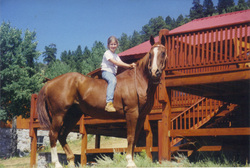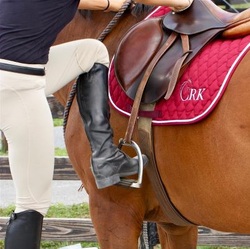We expect a lot from our horses. We climb on their back and want them to remain in balance with our added weight while going down the trail, jumping fences, performing the movements of dressage, or working a cow.
As riders, when we increase our own fitness, we can balance and move better, making the horse’s job easier. Our communication improves as our aids become clearer and more consistent.
Plus, when we feel stronger and more stable, our confidence increases.
The largest demographic of riders in the United States today are those who are starting or returning to riding later in life. Many initially see riding as a way to get fit, but the reality is that riding should be an incentive for fitness, not the only method to obtain it.
But what is the best way to work out as a rider? What kind of exercise can you do that will make a real difference in your riding?
Three “Tracks” of Rider Fitness
Riding requires a unique combination of physical skills. Riding is about organized movement, getting our whole bodies working better, not focusing only on strengthening certain muscles.
Think of your fitness as a rider progressing in three tracks: general cardiovascular fitness, balance and stabilizing, then body awareness.
Cardiovascular Fitness
 Cardiovascular fitness is your body’s ability to process oxygen into energy. If, for example, you find yourself out of breath after just a few minutes of trotting, you may need to increase your cardiovascular fitness. While you don’t need the stamina of a marathoner, riding does take energy and activates muscle groups, especially at the higher gaits of trot and canter.
Cardiovascular fitness is your body’s ability to process oxygen into energy. If, for example, you find yourself out of breath after just a few minutes of trotting, you may need to increase your cardiovascular fitness. While you don’t need the stamina of a marathoner, riding does take energy and activates muscle groups, especially at the higher gaits of trot and canter.
You want to be fit enough that you can ride at your current level without getting winded. Maintaining even breath goes a long way in promoting good, rhythmic movement from our horses. Keep in mind that there are other causes of feeling out of breath in the saddle – being nervous or out of balance can cause you to hold your breath, but we will discuss improving balance in the next section.
There are many ways to develop cardiovascular fitness. Basically, it’s about getting your heart rate up.
Pick a form of exercise you can enjoy. Walking, running, spin class, weight training, jumping jacks, even taking a dance class can all get your heart pumping. When doing any of these exercises, remember that interval training has been shown to be more effective than steady rate cardio.
Interval training simply means alternating high intensity exercise with low intensity recovery. Think running hard for a minute and then walking to recover. As with any form of growth if you want to improve you need to push past where you are comfortable.
If you groan at the idea of “traditional” exercise, think of other creative ideas. Go for a walk leading your horse, run around and play with your dog, take the stairs instead of the elevator, go hiking at a local park.
Balance and Stability
 Balance is obviously a very important skill for riding. When riding, we are off our own two feet and need to keep our weight centered over the quick moving animal underneath us.
Balance is obviously a very important skill for riding. When riding, we are off our own two feet and need to keep our weight centered over the quick moving animal underneath us.
The process of balance starts with our vestibular system, or inner ear, our organ of balance. Vision also plays a role in helping our brain determine where we need to be and how we need to
move, then our postural, or stabilizing, muscles, do the work of making the necessary adjustments to keep us upright within the field of gravity.
Stabilizing muscles lie deeper in the body, and are generally “slow-twitch” muscles, meaning they are designed for longer periods of activation.
We use our stabilizing muscles every day to move, stand, or sit. However – riding, and any exercise that requires balance, is going to use more of these muscles, and they can be strengthened just as any other muscle.
When our balance systems are not regularly challenged, they weaken. The good news is there are many exercises to improve balance that you can do off your horse.
Yoga and pilates are two very good exercise programs that focus on developing stabilizing muscle systems and improving balance.
There are also many simple ways to work on your balance throughout the day – stand on one leg as you are brushing your teeth, sit on an exercise ball at your desk, do some heel to toe walking around your house.
Body Awareness
Our third track of rider fitness is body awareness, an essential skill for effective riding. Body awareness means knowing where you are in space. We all have habits in our stance and movement, such as leaning to one side, rounding our shoulders forward, pulling harder with one arm, etc.
Increasing body awareness helps us become more aware of these often unconscious patterns, so we can better manage our bodies and posture while riding, know how much pressure we are (or are not) using, and be more consistent in how we apply riding aids.
These aren’t the exercises that are going to raise your heart rate, these are the exercises that will help you become more aware of how you are moving, so you can adjust and change.
Here are three examples of body awareness exercises that are also rider specific.
Pelvic clock: To do pelvic clock sit on a chair or exercise ball. Imagine that you were sitting on the face of a clock, with the hour of six o’clock behind you and twelve in front of you. Three is to your right and nine is to your left.
First, think about moving the top of your pelvis forward towards twelve, and then back towards six. Now move the top of your pelvis towards three o’clock on the right, then nine o’clock on the left.
Next, begin moving towards each number on the clock, starting by going forward toward twelve, and then the positions of one, two, and three on your right. Continue from there and then repeat on your left side.
You will likely find that moving to some numbers is very easy and others are more difficult. Close your eyes and feel the small isolated movement. Notice any other changes in your body – your breathing, feet on the floor, chest, etc. With a little practice, you will be able to reach each number on the clock and will have improved your awareness of the movement in your pelvis, which leads to clearer weight aids for your horse. (Pelvic Clock Exercise & Image courtesy of Wendy Murdoch)

Hula hooping: Pelvic mobility is big deal in riding. Many riders complain that their hips must be stiff, but physical range of motion is rarely the problem, rather it’s the awareness of movement that could be improved. Hula hooping is a great exercise to free up the movement in your hip joints and the many muscles that connect to the pelvis.
Before you roll your eyes and complain that you couldn’t even hula hoop when you were 14, try a weighted hoop. Larger, weighted hoops are much easier to use as they take less movement to keep them swinging around.
Start with just keeping the hoop going for one or two rotations and as you get more comfortable you can increase from there.
Roll Out Your Shoulders: This exercise improves movement through your elbows and shoulders. It is good for any rider, but especially helpful for improving your release in jump position.
Find a surface that is about level with your hips when sitting, such as in the picture below. Place your forearms on the foam roller, and slowly roll out and in. Feel the movement in your shoulders, but also your hip joints and back.
This exercise allows you to practice maintaining a flat back as well as feeling the mobility in your shoulders and hips.
Making it a Habit
The key to making real progress in your fitness is consistency. You will need to create new habits to keep you moving.
Start with one.
Consider the three tracks we’ve covered and decide which is currently your weak point.
Which fitness track – cardio, balance, or body awareness – if improved, do you feel could help you most in your riding and likely make the other two areas easier to work on?
When you have your answer, think about an easy way to start fitting this into your life. For example, if you decided that your best starting place is simply getting a bit more awareness of your body, you could make a little note that says “pelvic clock”, and put it on your computer at work. The note will serve as a cue to remind you to do this simple exercise when you sit down.
If you are feeling inspired to improve your fitness as a rider after reading this article, act now to get your new habit in place. Create that note from the previous example, set out your running shoes for the morning, pick up the phone and book a spot in a yoga class.
If you’re in Chester County Pa, come along and join our yoga classes at the Honey Brook Stables yoga studio!
With consistent effort you can get fit and feel at home in the saddle!

















38 Responses
Absolutely Wonderful suggestions. And not overly difficult to make a program of it. I do feel winded after a canter or two around the arena. I think I’ll take up some gentle running walking running walking. I do have yoga twice a week but will add the hula hoop – what a brilliant idea! Also the flat back roll out arms and shoulders sounds like a good awareness practice plus the pelvic click. Ok, I am inspired. Thank you.
Spin (cycling) classes have helped my cardio tremendously; plus it increases muscle strength through intervals of speed and ‘hills’. Yoga (I do Group Centergy at the Y) for core strength & balance. All helps to be fit for riding!
These are very helpful suggestions. They will help as I work to accomplish my goal of regaining my confidence and finding pleasure in riding at 74. Thanks, Callie!
So glad to hear, Pat! I will be turning 69 in August and after being gone from riding for nearly 33 years I returned about 4 years ago with many ups and downs! It seems every time I am making some promising progress over several months something happens that ends with my losing that momentum and even going backwards in my riding!! Thanks so much Callie! Your videos and Blog are truly inspiring and helpful!
Thank you Callie, Nicole and Pat. Never having touched a horse in my life, I started English riding lessons six years ago when I was 56. Needless to say, I’ve learned about muscle groups I didn’t even know I had! Callie, your videos have been a tremendous complement to my trainer’s efforts. Nicole and Pat, you inspire me. I know that soon, I’ll be able to keep the canter along with my stirrups! Thank you all.
Thank you so much for all your helpful tips. I incorporate them in my riding, as well as in my everyday life. It seems that my trainer and you are always on the same page, consequently giving me the assurance that I indeed picked the right place to ride again after a hiatus of 45 years. You are truly an asset to the riding community.
I love all the helpful tips. I’m soaking it all in 🙂
Thanks for this article, Callie. I have also recently taken up riding and am enjoying it immensely! And whereas I initially thought that riding would be an activity to improve my fitness, I now realize that although it has developed certain muscles and improved my balance, riding by itself is not going to get me fit or keep me fit in the strict sense. It’s more of an emotional pleasure and mental boost, with the added bonus of getting me moving and improving my mind/body coordination. At this point in my life, however, I am juggling preteenage kids/family needs, a career, and my own need for R&R/self-care. And riding is quite a time-consuming activity (every minute of which I love :), all the more so since I am looking to purchase my own horse in the coming year. Of course this means I will need to work more (I am a freelancer) to finance my new expensive hobby/lifestyle choice and will have potentially less time to “work out” by running or going to the gym, etc. Therein lies the dilemma! I am trying to work out the best balance of all these activities, but it’s no easy feat. I wonder how many others can relate — I’m guessing quite a few!
Working makes it harder to find the time for everything, so I can understand your dilemma. I have a full time job and a grandson who lives with me (age 4) with my daughter and husband, so have been off schedule on riding for almost 4 years now–I can fit in one class–called ballet-sculpt. It isn’t really ballet at all, but incorporates some of the moves. This is only an hour a week, and it works out your core pretty heavily, so if you can find something like that, it might get you there!
I am 44 and returned to riding 5 years ago. Riding has been a wonderful incentive for me to get more fit so I can be a better rider! My friends and I started a Plank “challenge” last week and I figured that’s a good way to work on my stabilizing muscles–correct? Thank you for the body awareness tips, I will try those.
The weighted hula hoop is definitely easier than the dollar store one I bought for my dog to jump through. Body awareness is my downfall – I will try these exercises. The best balance exercise I’ve done has been to ride bareback for 3 months. It taught me to balance myself on my seat rather than on my legs in the saddle.
Three years ago I made the decision to change my ATTITUDE toward exercise…from being a double-4-letter-word to being a happily-chosen lifestyle preference! I workout with others, for accountability. I am fortunate to be able to work with riding instructos and a personal trainer (3x a week with both) to do all that you suggest, but there are equine exercise books for riders and horses, if one cannot work with others. Just DO IT. I have aerobic endurance and muscle strength I haven’t seen in decades, plus I feel better than I did in my early 40’s. All because I wanted to learn how to jump! Be kind to yourself, remember to take reasonable, incremental baby steps so you can enjoy your journey becoming a stronger, better rider!
Well said, Harriet. The key is reasonable, incremental, and CONSISTENT steps.
Awesome Harriet! Congratulations on your new strength and fitness!
Fantastic post. I am a personal trainer who was addicted to exercise. I’ve recently had major surgery and cant ride or exercise for 6 weeks! Its killing me. I am counting down the days but I know I will be starting over and very weak. Its such an empowering thing to feel yourself growing stronger and see your riding improve. I’m looking forward to it!!
Interesting Hula Hoop site
https://www.canyonhoops.com/shop-hula-hoops/
That’s great! A whole site of hula hoops!
I went to the web site, and that made me realize there are videos that show how to hulu hoop. I googled how to hula hoop. Thank you, Brenda, for the idea of hula hooping. I’m one of those people Callie mentions that looks for more creative ways of exercising than traditional exercises.
And thank you, Callie, for the idea of hula hooping.
Greetings Callie,
Luv your videos……very good. Thankyou .
Started my yoga again and you don’t realize how unsupple one is until doing/trying plough pose lol…..
Haha! Thank you Pete, glad you enjoy the videos, and keep up with that plough pose, lol!
thank you again as always, your a wonderful riding coach, and the timing couldn’t be better.
great to hear all the comments. Think a weighted hula hoop is next on my shopping list!
As Robyn said, above, you are a great coach and the timing for us to focus on rider fitness is wonderful 🙂 Thank you so much !!
Hi Callie, I feel this blog speaks directly to me. Your incredible insight is spot on! Thank you for breaking down the various components and also for coaching us to tackle one at a time based on our personal gaps. Forever grateful.
WAITING FOR MY NEW HOOLA HOOP !
Callie,
This blog is very well-written and helpful! Personally, I have focused first on cardio-vascular fitness, as I was noticing as I started to learn a rising trot that I was getting winded sooner that I would have liked. This despite being strong and in excellent shape for my age (50) on account of doing physical work and lots of exercise daily. I made it a priority to fit cycling into my schedule, aiming to ride at least 45 miles a week. Six months later, I am finding that I can ride a posting trot for much longer, although that is also due to being more efficient and economical with my motions. Without a doubt though, I feel the fittest and strongest I have ever felt in my life!
As I ride horses, I am not finding that balance is ever a problem, but I am finding that my body-awareness is sometimes hindering my riding. While I like to laugh it off as a problem common to all men, I know it is actually something that I would benefit greatly from working on. Thank you so much for suggesting some exercises that will help!
May sound funny, but belly dancing helped me- isolation of correct posture: hip, legs, back and arms really made me aware of my body in space and improved my balance. My instructor shared with me she’s had more than one equestrian tell her this!
I’ve taken belly dance before, and so that doesn’t sound funny to me.
I do yoga twice a week and it really does help with balance and core.
I do feel a bit winded after heavy horse work so I’ve started walking and then jogging with my horse..stop start like you suggest.
And I love the hula hoop idea
Thank you for your blogs and videos
Hi Callie,
By far this has been one of the most helpful posts fo me. I have been working on building core strength, as I have lost much of that since being unable to ride for a while. (Not sure I had enough before that, for that matter.) But while core strength is helping my balance a great deal, these exercises seem to me geared more specifically to riding; we use the same muscles, but use them differently. Thanks for posting this. I do take a quasi-dance class, and am planning to start a yoga one next week. Winter is a good time for this, since the weather here in Missouri hasn’t been great for any kind of riding outside!
Hi. I am 66 years old, and have not ridden for about 25 years, and that was for an afternoon while in s. Dakota. I rode a lot from ages 11 until 17. I never owned my own horse, but traded barn work and caring for the horses in exchange for riding, trail and some minor showing. My love for horses has been rekindled, and I would love to ride again. I am concerned that I my be too old and out of shape. I have no connection to horse people here in northern Michigan, but am working on a source. I am not financially well off at all, but thought I would begin with some volunteering to help someone who could use some extra help with their horse\horses. Also looking for a local horse rescue who may need help. Maybe work into some riding. Anyway, I guess I just wanted some encouragement! Need to start exercising! Thanks for the workout suggestions! Would love to get back in the horse circle in some small way!
Hi Jane! A great way to get more experience is volunteering at a local horse rescue or therapy center. Many of those organizations will do a work to ride type of arrangement and give you a great opportunity to spend more time around horses. Our community is full of riders of a variety of ages at a wide range of experience levels, you have come to the right place here at CRK Training 🙂 Julia Burdy, CRK Training Community Manager
Hi Jane, I’m also 66 and rode as a youngster, quit for 25 years and got back into it. If you’re like me, you’re not too old, but you have to work a little harder now to stay in shape to ride. I volunteer with an equine rescue and I’ve helped at equine therapy programs in the past — I’m sure you’d be welcome as a volunteer. One of my biggest challenges is my posture, and there are some excellent YouTube videos to help you improve if that’s a concern. For me, a program called Chi Walking has helped me get my head, shoulders, hips and feet aligned, and helped me engage my core. That translates to better posture on the ground and in the saddle. Don’t give up, even though you’re not a youngster anymore!
Hi there! I live in southern Michigan and have rekindled my love of riding at age 60. I’m hoping you find an avenue to work into it! Blessings, Sonia
I’m 69 been having lessons for 16 months now. I started doing Pilates for core strength and found this really helpful. I am lucky enough to be quite fit, as well as Pilates I use a gym ball, do quite a bit of walking. Probably the best workout I get is on the horse! I find now I don’t get breathless in rising trot or sitting trot, have done a little bit of canter on a slow horse (very lumpy!) Am having a lesson tomorrow on the faster horse cantering! Horseriding is the best ever, I hope to be doing this for many years to come!
Hi Andrea,
good on you!!! keep it up,
best wishes
Robyn
Awesome Andrea! Core stability is great for riding 🙂
-Julia Burdy, CRK Training Community Manager
I love to read this! I am 64 and hope to ride many more years.